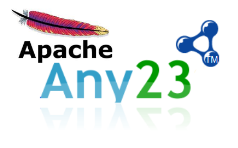Apache Any23 REST Service
Apache Any23 provides REST Service module any23-service able to provide useful processing methods.
Compact API
HTTP GET requests can be made to IRIs of the shape:
http://<any23-service-host>/<output-format>/<input-uri>
Where input-uri is the input HTTP resource to be processed and output-format is the desired output format for the extracted RDF data.
Example requests:
http://any23.org/best/twitter.com/cygri http://any23.org/rdfxml/http://data.gov http://any23.org/ttl/http://www.w3.org/People/Berners-Lee/card http://any23.org/?uri=http://dbpedia.org/resource/Berlin http://any23.org/?format=nt&uri=http://dbpedia.org/resource/Berlin
Supported input and output formats are described here.
Form-style GET API
HTTP GET requests can be made to the IRI http://any23.org/ with the following query parameters:
uri IRI of an input document format Desired output format; defaults to best
Direct POST API
HTTP POSTing a document body to http://any23.org/format will convert the document to the specified output format. The media type of the input has to be specified in the Content-Type HTTP header. Depending on the servlet container, a Content-Length header specifying the length of the input document in bytes might also be required. Typical media types for supported input formats are:
Input format Media type ------------------------------- HTML text/html RDF/XML application/rdf+xml Turtle text/turtle N-Triples text/plain N-Quads text/plain
Example POST request:
POST /rdfxml HTTP/1.0
Host: any23.org
Content-Type: text/turtle
Content-Length: 174
@prefix foaf: <http://xmlns.com/foaf/0.1/> .
[] a foaf:Person;
foaf:name "John X. Foobar";
foaf:mbox_sha1sum "cef817456278b70cee8e5a1611539ef9d928810e";
.Form-style POST API
A document body can also be converted by HTTP POSTing form data to http://any23.org/. The Content-Type HTTP header must be set to application/x-www-form-urlencoded. The following parameters are supported:
| type | Media type of the input, see the table above. If not present, auto-detection will be attempted. |
| body | Document body to be converted. |
| format | Desired output format; defaults to best. |
| validation | The validation level to be applied, supported values: none (default), validate and validate-fix. |
Output Formats
Supported input and output formats are described here.
Error reporting
Processing errors are indicated via HTTP status codes and brief text/plain error messages. The following status codes can be returned:
Code Reason ------------------------------------------------------------------------------------------------------------- 200 OK Success. 400 Bad Request Missing or malformed input parameter. 404 Not Found Malformed request IRI. 406 Not Acceptable None of the media types specified in the Accept header are supported. 415 Unsupported Media Type Document body with unsupported media type was POSTed. 501 Not Implemented Extraction from input was successful, but yielded zero triples. 502 Bad Gateway Input document from a remote server could not be fetched or parsed.
XML Report Format
The Apache Any23 Service can optionally return an XML report and attempt error fix if the flags fix and report are activated ( fix=on&report=on ). The following URL shows how to use these flags.
http://any23.org/any23-service/any23/?format=best&uri=http%3A%2F%2Fpath%2Fto%2Fresource&validation=none&report=on
The fix functionality is described here.
A report format example is listed below. In particular ath path response/extractors/extractor it is possible to find the list of all extractors activated during the page processing. The section response/report/message contains an eventual error message while the response/report/error section the error stack trace if available.
The result of validation is contained within the response/report/validationReport node. Within that node there is the list of the activated rules, the issues detected and the errors generated.
<?xml version="1.0" encoding="UTF-8" ?>
<response>
<!-- List of activated extractors. -->
<extractors>
<extractor><!-- Extractor name. --></extractor>
<!-- ... -->
</extractors>
<report>
<message></message>
<error></error>
<!-- Validation specific report, contains all errors and issues detected within the document. -->
<validationReport>
<!-- List of errors found while validating the document. -->
<errors>
</errors>
<!-- List of issues found while validating the document. -->
<issues>
</issues>
<!-- List of rules activated to solve the detected issues. -->
<ruleActivations>
</ruleActivations>
</validationReport>
</report>
<data>
<![CDATA[
-- Actual Data in the format specified as output. --
]]>
</data>
</response>


